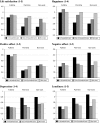Feeling the squeeze? The effects of combining work and informal caregiving on psychological well-being
- PMID: 28804345
- PMCID: PMC5549215
- DOI: 10.1007/s10433-014-0315-y
Feeling the squeeze? The effects of combining work and informal caregiving on psychological well-being
Abstract
Does employment provide respite or add stress to caregivers? As a result of population aging and increasing female employment rates, growing numbers are facing the competing demands of paid work and caregiving. This study explores the effect of providing regular personal care by employment status on six dimensions of psychological well-being. We concentrate on partner and parent care recipients and differentiate between in-household and out-of-household caregiving. We use cross-sectional data from the Norwegian Life Course, Ageing and Generation study (n = 11,047, age 25-64). Results indicate that out-of-household caregiving has no significant relationship with men or women's well-being, irrespective of employment status. In-household caregiving, however, relates to lower psychological well-being, but only among women who do not work full-time. The advantages of full-time employment to caregivers may be due to greater opportunity to achieve the full benefits that this role has to offer. There is little to suggest that combining work and caregiving harms well-being. In fact, a "double burden" seems to be experienced by women who combine extensive caregiving with limited employment.
Keywords: Caregiving; Employment; Norway; Personal care; Psychological well-being.
Figures
Similar articles
-
The Psychological Effects of Providing Personal Care to a Partner: A Multidimensional Perspective.Health Psychol Res. 2013 Jul 30;1(2):e25. doi: 10.4081/hpr.2013.e25. eCollection 2013 Apr 18. Health Psychol Res. 2013. PMID: 26973910 Free PMC article.
-
Are informal caregivers less happy than noncaregivers? Happiness and the intensity of caregiving in combination with paid and voluntary work.Scand J Caring Sci. 2013 Mar;27(1):44-50. doi: 10.1111/j.1471-6712.2012.00998.x. Epub 2012 May 10. Scand J Caring Sci. 2013. PMID: 22571683
-
Caregiving, Employment and Social Isolation: Challenges for Rural Carers in Australia.Int J Environ Res Public Health. 2018 Oct 16;15(10):2267. doi: 10.3390/ijerph15102267. Int J Environ Res Public Health. 2018. PMID: 30332790 Free PMC article.
-
[Impact of caregiving on women's health and quality of life].Gac Sanit. 2004;18 Suppl 2:83-92. doi: 10.1157/13061998. Gac Sanit. 2004. PMID: 15171848 Review. Spanish.
-
Changing factors and changing needs in women's health care.Nurs Clin North Am. 1986 Mar;21(1):111-23. Nurs Clin North Am. 1986. PMID: 3513129 Review.
Cited by
-
Full-time versus part-time employment: Does it influence frequency of grandparental childcare?Eur J Ageing. 2015 Jul 8;12(4):321-331. doi: 10.1007/s10433-015-0349-9. eCollection 2015 Dec. Eur J Ageing. 2015. PMID: 28804364 Free PMC article.
-
Transitioning into informal care and occupational self-efficacy : A difference-in-differences propensity score matching analysis using representative German employee data.Z Gerontol Geriatr. 2025 Aug 28. doi: 10.1007/s00391-025-02481-x. Online ahead of print. Z Gerontol Geriatr. 2025. PMID: 40875005 Review. English.
-
Caring for Patients with Psychosis: Mental Health Professionals' Views on Informal Caregivers' Needs.Int J Environ Res Public Health. 2021 Mar 14;18(6):2964. doi: 10.3390/ijerph18062964. Int J Environ Res Public Health. 2021. PMID: 33799346 Free PMC article.
-
A Study of Social Isolation, Multimorbidity and Multiple Role Demands Among Middle-Age Adults Based on the Canadian Longitudinal Study on Aging.Int J Aging Hum Dev. 2022 Apr;94(3):312-343. doi: 10.1177/00914150211040451. Epub 2021 Oct 12. Int J Aging Hum Dev. 2022. PMID: 34636660 Free PMC article.
-
Impact of Caregiving on Various Aspects of the Lives of Caregivers.Cureus. 2017 May 2;9(5):e1213. doi: 10.7759/cureus.1213. Cureus. 2017. PMID: 28589062 Free PMC article.
References
-
- Biddle BJ. Recent developments in role theory. Ann Rev Sociol. 1986;12:67–92. doi: 10.1146/annurev.so.12.080186.000435. - DOI
-
- Bowling A. Measuring health: a review of quality of life measurement scales. Maidenhead: Open University Press; 2005.
-
- Chung H, Tijdens K. Working time flexibility components and working time regimes in Europe: using company-level data across 21 countries. Int J Hum Resour Man. 2013;24:1418–1434. doi: 10.1080/09585192.2012.712544. - DOI
LinkOut - more resources
Full Text Sources
Other Literature Sources
Research Materials


